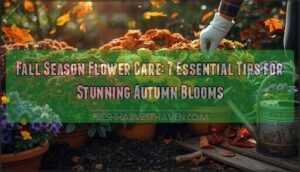This site is supported by our readers. We may earn a commission, at no cost to you, if you purchase through links.

Choose hardy varieties like asters and pansies that thrive in cooler temperatures. Prepare beds with compost amendments for ideal drainage and nutrient density. These foundational steps reveal secrets to professional-quality autumn displays that’ll have neighbors asking for your blueprint.
Table Of Contents
- Key Takeaways
- Fall Flower Care Basics
- Planting Fall Flowers
- Caring for Mums
- Fall Garden Maintenance
- Winterizing Garden Mums
- Fall Bloomer Care Tips
- Preparing for Winter
- Frequently Asked Questions (FAQs)
- How do you take care of fall flowers?
- Should you cut your flowers back in the fall?
- What should be done to perennial plants in the fall?
- Should I water my flowers in the fall?
- Should you deadhead flowers in the fall?
- Which fall flower lasts the longest?
- Should you change your garden to a fall flower?
- When should you plant fall flowers?
- When do fall flowers come out?
- What flowers can you plant in the fall?
- Conclusion
Key Takeaways
- Plant mums one inch deeper than their containers in well-draining soil with 6+ hours of sunlight and space them 2.5-3 feet apart for proper airflow and disease prevention.
- Water deeply once or twice weekly using morning schedules to prevent disease, and adjust frequency as temperatures drop below 40°F to avoid overwatering issues.
- Apply balanced 5-10-10 fertilizer monthly until temperatures consistently drop below 50°F, then stop feeding to prevent frost-tender growth before winter.
- Deadhead spent flowers regularly to extend blooming periods by up to six weeks and redirect plant energy into producing more vibrant fall displays.
Fall Flower Care Basics
Fall’s cooler temperatures and shorter days create perfect conditions for vibrant autumn blooms, but you’ll need to adjust your gardening approach to help your flowers thrive.
Proper planting timing, soil preparation, watering schedules, and fertilizer application become essential as your garden shifts from summer’s heat to winter’s chill.
Planting Mums
When you’re planting mums for fall flower care, timing and technique make all the difference. Plant your chrysanthemums one inch deeper than their nursery containers to encourage healthy root development that’ll weather autumn’s challenges. Proper mum spacing prevents overcrowding and disease, while container planting requires extra attention to drainage.
Here’s your planting roadmap:
- Select locations with 6+ hours of direct sunlight – your fall flowers need this energy boost
- Space garden mums 2.5-3 feet apart – adequate airflow prevents fungal issues
- Water thoroughly after planting – this eliminates air pockets and settles roots
Consider companion plants that complement your mums’ autumn display. Soil amendments aren’t necessary yet, but proper planting time matters. Mid-to-late August offers ideal conditions for caring for mums.
Choosing Right Soil
Success starts with understanding your soil’s foundation. Your mums thrive in well-draining soil with a pH between 6.0-7.0 for ideal nutrient absorption. Heavy clay retains too much moisture, while sandy soil drains excessively fast.
Garden soil preparation involves mixing compost additives like aged manure to boost nutrient density and improve drainage needs. For containers, choose quality potting mix over garden soil.
Test your soil pH before planting to determine necessary soil enrichment. Proper soil preferences create the perfect environment for healthy mum growth.
Watering Techniques
Once you’ve got the right soil sorted, mastering watering techniques will keep your fall flowers thriving through temperature drops. Adjust your watering schedule as cooler weather reduces evaporation rates. Deep watering promotes strong root development while preventing the shallow root systems that lead to wilting.
Consider these watering techniques for fall season flower care:
- Drip irrigation systems deliver water directly to soil, reducing waste and prevent overwatering
- Morning watering allows plants to absorb moisture before evening temperature drops
- Soil moisture checks guarantee you’re providing ample water without drowning roots
Focus water at the base of mums and other fall bloomers, avoiding wet foliage that invites disease.
Fertilizer Application
Your garden’s nutritional needs change with cooler weather, making balanced fertilizer application vital for vibrant autumn displays. Apply balanced fertilizer with a 5-10-10 ratio monthly until temperatures consistently drop below 50°F. Stop feeding newly planted annuals to prevent frost-tender growth. A 5-10-10 fertilizer blend is commonly used.
Fall fertilizing is your garden’s secret weapon—balanced nutrition creates stunning blooms that last until frost
| Fertilizer Types | Application Methods | Nutrient Timing |
|---|---|---|
| Balanced 5-10-10 | Granular around base | Monthly until 50°F |
| High-phosphorus | Water-soluble spray | Early fall only |
| Organic compost | Work into soil | Late summer prep |
| Slow-release pellets | Broadcast evenly | August application |
| Liquid concentrate | Dilute and water | Bi-weekly schedule |
Soil Testing reveals Deficiency Symptoms before they appear—yellowing leaves often signal nitrogen needs, while poor blooming indicates phosphorus shortage. Consistent fertilizer application guarantees your mums and asters maintain their stunning colors through frost.
Planting Fall Flowers
Selecting the right fall flowers transforms your garden into a vibrant autumn showcase that’ll impress neighbors and extend your growing season.
You’ll want to choose a mix of annuals for instant color and perennials for long-term investment, plus consider adding climbing vines and flowering shrubs to create layers of visual interest throughout your landscape.
Annual Flowers for Fall
Annual flowers bring continuous fall blooming magic to your autumn garden. Pansies handle frost like champs, delivering vibrant colors for over two months in mild climates. Calendula benefits include attracting pollinators while providing stunning yellow and orange hues for up to ten weeks. Zinnia varieties offer pink, orange, and white blooms lasting through early October. Nasturtium care is simple—they thrive in cooler temperatures. Marigolds rebound beautifully after summer heat stress.
Annual deadheading increases flower count by 35%, extending your fall season flower care success. Frost protection using row covers helps tender annuals survive unexpected cold snaps.
Many gardeners appreciate that fall flowers require less watering than summer blooms.
Perennial Flowers for Fall
Beyond basic annuals, perennial flowers for fall create lasting beauty in your autumn landscape. Asters varieties like New England and aromatic asters bloom spectacularly through October, while Joe-Pye weed attracts butterflies with towering purple blooms.
Fall planting establishes strong roots before winter dormancy. It also helps reduce transplant shock in plants.
Dividing perennials in autumn rejuvenates overcrowded clumps—simply dig, split, and replant for healthier fall blooming perennials next season.
Vines for Fall Color
For maximum impact with minimal space, vines deliver stunning fall color that transforms any vertical surface. These climbing champions create dramatic seasonal displays while requiring smart vine selection and proper care techniques.
Here are five top performers for autumn gardens:
- Virginia creeper blazes with vibrant red and purple foliage in zones 3-9
- Boston ivy turns deep crimson, providing excellent coverage on walls
- Sweet autumn clematis produces fragrant white flowers through fall
- Trumpet vine attracts hummingbirds with orange-red blooms
- Japanese hydrangea vine displays golden fall foliage with heart-shaped leaves
Ensure proper trellis support and pruning techniques for ideal growth. Winter protection helps established vines survive harsh conditions.
Fall Shrubs and Trees
While vines bring vertical beauty, shrubs and trees form your garden’s backbone with lasting fall color and winter protection. Plant these woody companions six weeks before frost for proper root establishment. Considering the potential plant size is vital for a successful garden design.
| Fall Shrubs | Fall Trees |
|---|---|
| Oakleaf hydrangea displays crimson autumn color | Sweetgum trees offer reliable fall foliage |
| Beautyberry produces purple berries through winter | Paperbark maple shows cinnamon-colored bark |
| Red chokeberry attracts birds with bright fruit | Japanese maple varieties suit smaller spaces |
| Smokebush provides purple-burgundy fall color | Blackgum delivers dramatic autumn displays |
Smart tree planting and shrub pruning now guarantees remarkable displays later. These selections reward you with disease control benefits and natural winter protection for surrounding plants.
Caring for Mums
Mums are the stars of fall flower gardens, but they need specific care to reach their full potential. Understanding their basic requirements for sunlight, soil, water, and nutrients will help you achieve those vibrant autumn displays you’re after.
Sunlight Requirements
Successfully positioning your fall flowers requires strategic sunlight planning for maximum bloom production throughout the autumn months. Your mums need consistent light duration to maintain their vibrant displays and prevent weak, spindly growth that compromises their natural beauty.
Here’s your fall garden sunlight requirements checklist:
- Provide 6-8 hours daily – Direct morning and afternoon light guarantees successful fall flower care success
- Choose ideal placement – East-facing locations capture essential early sunlight while avoiding harsh midday intensity
- Avoid shaded areas – Locations with less than 4 hours cause poor blooming and stretched stems
- Consider sunburn prevention – Hot afternoon sun can stress plants, so some filtered light helps during peak hours
- Monitor seasonal changes – Fall’s shifting sun patterns require adjustments to maintain adequate exposure
Remember, different mum varieties have varying light needs. Decorative types often demand slightly more exposure than standard garden varieties.
Proper sunlight requirements directly impact your fall season flower care success, determining whether you’ll enjoy weeks of stunning blooms or disappointingly sparse displays.
Soil Preferences
Your mums’ success starts with choosing the right soil foundation. These fall flowers demand well-draining soil with a pH between 6.0-7.0 for ideal growth. Heavy clay or waterlogged conditions destroy root systems faster than winter frost.
| Soil Factor | Ideal Range | Amendment Options |
|---|---|---|
| Soil pH | 6.0-7.0 | Lime or sulfur |
| Drainage Needs | Well-draining | Compost, perlite |
| Organic Matter | 25-30% | Aged manure, leaves |
| Nutrient Levels | Moderate fertility | Balanced fertilizer |
Test your fall garden soil before planting. Poor drainage kills more mums than cold temperatures. Boost nutrient density through compost additions, which improve both drainage and soil enrichment simultaneously for healthier fall flowers.
Watering Mums
Check your potted mums every other day for watering frequency. Deep watering works better than shallow drinks—give them one inch weekly to avoid underwatering symptoms like wilting. Focus water at the base, avoiding leaves for proper drainage solutions.
As temperatures drop below 40°F, reduce watering frequency gradually. Watch for overwatering signs like yellowing leaves in your fall garden.
Fertilizing Mums
Perfect watering sets the stage for proper nutrition. Understanding your mums’ Nutrient Needs guarantees vibrant blooms throughout fall. Soil Testing reveals what nutrients are lacking before you begin Fertilizer Application.
Spring-planted mums thrive with monthly balanced fertilizer until temperatures drop, while fall-planted varieties need different care. Stop feeding established perennials in late summer to prevent tender growth before frost.
Smart fertilizing practices include:
- Apply Fertilizer Types like 5-10-10 one month after first frost
- Watch for Over-Fertilizing Signs like excessive foliage with fewer blooms
- Choose organic options for gentle, sustained nutrition
- Time Application Timing based on Planting Mums season and current weather
Fall Garden Maintenance
Fall maintenance keeps your flower beds healthy and thriving through the season. You’ll need to tackle basic yard tasks that directly impact your blooms’ performance and prepare your garden for the cooler months ahead.
Raking Fallen Leaves
Regular leaf removal prevents smothering your flower beds and maintains healthy air circulation. Raking alternatives like mulching mowers handle lighter coverage efficiently, while composting leaves creates valuable soil amendment for next season. Consider leaf mulching around perennials for natural insulation, or leave some areas untouched to provide wildlife habitat.
This fall garden cleanup strategy balances plant health with ecosystem benefits during leaf decomposition season. You can also fertilize cool-season grasses for root development.
Seeding or Laying Sod
Once you’ve cleared fallen leaves, tackle bare lawn spots with smart Seed vs Sod decisions. Fall Seeding offers ideal conditions—cooler temperatures boost Seed Germination rates by 30% compared to spring. Soil Preparation starts with loosening compacted earth and adding compost for Choosing Right Soil conditions.
Sod Installation delivers instant results but requires careful Root Establishment monitoring. Both methods need consistent Watering Schedules:
- Daily light watering for three weeks with seeds
- One inch weekly for sod until roots anchor
- Monitor soil moisture to prevent drought stress
- Use mulching to improve germination by 15%
Aerating High-Traffic Areas
High foot traffic creates soil compaction that chokes your fall flowers’ root health. You’ll need aeration tools like core aerators to punch holes and improve proper drainage. Fall’s ideal timing since growth slows down.
Rent spike or plug aerators, then overseed bare patches. This drainage improvement transforms compacted walkways into thriving flower zones, supporting healthy soil preferences and better watering techniques for your fall flower care routine.
Controlling Weeds
Cool autumn nights bring persistent weeds that’ll crowd your fall garden maintenance efforts. Start with proper weed identification – knowing your enemy makes herbicide options more effective. Manual removal works perfectly for small patches, while selective treatments handle stubborn perennials. A useful weed recognition resource can greatly assist in this process.
Apply fresh mulch application around blooms to block new growth. These prevention tactics during garden cleanup stop weeds before they compete with your flowers, ensuring your fall garden cleanup protects those stunning autumn displays you’ve worked hard to create.
Winterizing Garden Mums
As autumn arrives, your garden mums need special care to survive winter’s harsh conditions and return stronger next spring. Proper winterizing techniques will protect these hardy perennials from freezing temperatures while encouraging healthy growth for vibrant blooms in the coming year.
Mulching Perennials
Apply mulch around perennials after the second frost to create essential winter protection. This gardening practice safeguards roots from temperature fluctuations while enhancing soil health throughout the dormant season. To further protect your plants, consider insulating soil with mulch.
- Select organic mulch types like shredded bark, straw, or compost for maximum insulation
- Maintain 3-4 inch application depth around plant bases without touching stems
- Create pest control barriers by keeping mulching materials away from crowns
- Focus on tender perennial flowers that require extra winter protection
- Apply mulch for insulation when soil temperatures consistently drop below freezing
Protecting Plants From Cold
When frost threatens your fall blooms, don’t panic. Row covers and frost protection fabric shield tender petals from cold snaps. Water thoroughly before freeze events—moist soil holds warmth better than parched ground.
Mulch application around plant bases provides essential insulation for winter hardiness.
Move container plants to protected spots like covered porches when temperatures plummet below freezing for extended periods.
Pinching Tips for Fuller Growth
When you master pinching techniques for fall season flower care, you’ll transform spindly mums into bushy showstoppers. Timing matters—start when stems reach 4–6 inches, usually in late spring through mid-summer. Use clean pinching tools like scissors or your fingernails to remove 1–2 inches of growing tips. This simple action triggers encouraging bushiness by forcing side shoots to develop, ultimately promoting blooms throughout fall. Deadheading flowers works alongside pinching for maximum impact.
Here’s your fall flower care action plan:
- Begin pinching tips when stems hit 4–6 inches tall
- Remove growing points every 2–3 weeks until mid-July
- Use sanitized tools to prevent disease spread
- Stop pinching 10–12 weeks before desired bloom time
- Water thoroughly after each pinching session
Pruning Deciduous Species
When deciduous plants shed their leaves, Timing Matters for Pruning Deciduous Species. Proper Pruning during the dormancy cycle guarantees fall shrubs and trees recover effectively before spring growth.
| Pruning Techniques | Tool Selection | Wound Treatment |
|---|---|---|
| Remove weak branches | Sharp bypass pruners | Clean cuts heal faster |
| Eliminate crossing limbs | Loppers for thick stems | Seal large wounds |
| Shape for structure | Hand saw for major cuts | Monitor for disease |
Focus on Species Specifics when timing cuts. Fall foliage signals dormancy’s arrival, making it your green light for action. Clean tools prevent disease spread between plants.
Fall Bloomer Care Tips
Your fall blooms need consistent attention to maintain their vibrant display through the season’s changing conditions. With proper care techniques, you’ll keep your autumn flowers healthy and colorful until the first hard frost arrives.
Maintaining Garden Tidiness
Tidy up your garden by tackling leaf removal and debris cleanup systematically. Remove diseased debris first, then deadhead spent blooms to redirect plant energy. Rake fallen leaves that smother flower beds, and trim damaged stems with clean tools for proper tool storage.
This fall garden maintenance prevents pests from overwintering while setting up winter preparation success for healthier spring growth.
Providing Ample Water
Proper watering frequency directly impacts your fall blooms’ success and root development. Check soil moisture two inches deep—dry soil means it’s watering time. Adjust your irrigation schedule as temperatures drop, shifting from weekly to bi-weekly routines.
- Drip irrigation systems deliver water directly to roots, reducing evaporation
- Deep, infrequent watering encourages stronger root systems than shallow, frequent sprinkling
- Preventing wilt requires consistent moisture monitoring, especially for watering mums during temperature fluctuations
Protecting Sensitive Plants
While adequate watering keeps your blooms thriving, protecting sensitive plants from cold snaps becomes your next priority. When frost threatens, deploy these proven frost protection strategies to safeguard tender flowers.
| Protection Method | Best For | Temperature Range |
|---|---|---|
| Mulch application | Root protection | Down to 25°F |
| Row coverings | Tender annuals | 28-32°F range |
| Burlap wraps | Delicate perennials | Early frost events |
| Cold frames | Seedlings/starts | Extended protection |
Apply thick mulch around plant bases before winter hardiness tests arrive. Use frost blankets or cloth coverings during overnight temperature drops, removing them when temperatures rise to prevent overheating your protected plants.
Sharpening Tool Blades
While protecting sensitive plants safeguards your garden’s vulnerable inhabitants, keeping your tools razor-sharp promotes every cut to foster healthy growth rather than inviting disease. Think of tool maintenance as preventive medicine for your autumn blooms.
Sharp blades create clean wounds that heal faster, while dull tools crush plant tissue and open doorways for infections. Here’s your sharpening roadmap for fall garden maintenance:
- Maintain proper blade angle – Most pruning shears need a 20-25 degree bevel for exceptional cutting performance
- Use appropriate sharpening stone – Start with coarse grit (400) and finish with fine (1000) for razor-sharp edges
- Remove burrs completely – Run a leather strop along the blade’s back edge to eliminate metal fragments
- Follow safety gear protocols – Always wear protective eyewear and gloves during tool maintenance sessions
- Establish regular schedules – Sharpen tools monthly during peak growing season, weekly during heavy autumn pruning
Your honing techniques directly impact plant health outcomes:
- The satisfaction of smooth cuts through thick stems
- Pride in tools that last decades with proper care
- Confidence knowing each snip promotes plant healing
- Relief from reduced hand fatigue during long pruning sessions
- Joy watching flowers thrive after precise, clean cuts
Well-maintained equipment transforms garden maintenance from chore to craft.
Preparing for Winter
As winter approaches, you’ll want to shift your focus from maintaining blooms to protecting your garden’s foundation for next year’s success. This vital preparation phase guarantees your flower beds emerge healthy and ready to flourish when spring returns.
Cleaning Out Beds
After protecting your plants from harsh weather, fall garden cleanup becomes your next priority. Start debris removal by clearing fallen leaves, spent blooms, and diseased stems from flower beds. This pest prevention step eliminates overwintering habitats for harmful insects and fungal spores.
Remove dead annuals completely, but leave ornamental grass seed heads for wildlife. Focus on cleaning out beds thoroughly, as proper fall garden maintenance prevents spring problems.
Your diligent garden cleanup efforts now set the stage for healthier soil enrichment and strong spring growth.
Storing Gardening Accessories
Once beds are clean, your gardening accessories deserve proper storage to survive winter’s harsh conditions. Organization prevents the spring scramble when you’re keen to start gardening again.
- Tool Rust Prevention: Clean and oil metal tools before storing in weatherproof container options
- Shed Organization Ideas: Use labeled bins and pegboards for easy inventory management tips
- Secure Storage Solutions: Store chemicals away from temperature extremes in locked cabinets
- Tool Maintenance: Sharpen and repair equipment now for spring readiness
Adding Compost to Soil
Once you’ve stored your garden tools properly, boost your soil’s health by mixing compost into tired fall beds. This winter preparation step creates the perfect foundation for stunning blooms next season.
Fresh compost transforms your garden soil like a nutritional power-up for plants. The organic matter works slowly through winter months, delivering steady nutrients when spring arrives. Your fall season flower care investment will pay off handsomely.
Here’s how compost benefits your soil:
- Nutrient cycling – Organic matter releases essential minerals gradually throughout winter
- Drainage improvement – Compost prevents waterlogged roots in heavy clay soils
- Enhanced structure – Blending creates better soil texture and porosity
- Beneficial microbes – Introduces helpful bacteria that fertilize plants naturally
Work compost into beds now for healthier soil enrichment. Strategic mulch application shields against compaction, and you can apply a thick layer of mulch before the ground freezes.
Planting Cover Crops
Cover crops transform your garden into a soil enrichment powerhouse while you rest. Plant winter rye or crimson clover 4-6 weeks before frost for maximum erosion control and nitrogen fixation.
These green guardians suppress weeds, boost beneficial microorganisms, and decompose into rich organic matter by spring—giving your fall season flower care routine a serious upgrade.
Frequently Asked Questions (FAQs)
How do you take care of fall flowers?
You’ll want to adjust watering as temperatures drop, plant hardy mums and asters for color, deadhead spent blooms regularly, and protect tender plants with mulch before frost arrives.
Should you cut your flowers back in the fall?
It depends on the type. Cut back diseased perennials like peonies to prevent winter problems, but leave ornamental grasses and seed heads standing for wildlife habitat.
What should be done to perennial plants in the fall?
Like autumn leaves preparing for winter’s slumber, your perennials need thoughtful care. Protect tender ones with mulch, deadhead spent chrysanthemum blooms, cut back disease-prone plants like peonies, but leave ornamental grasses standing.
Should I water my flowers in the fall?
You should water your flowers in the fall, but cut back as temperatures drop. Overwatering leads to soggy roots. Aim for deep, less frequent watering—think of it as training your plants for winter boot camp.
Should you deadhead flowers in the fall?
Though many think deadheading isn’t worth it in fall, you should definitely continue this practice. Removing spent blooms on chrysanthemums encourages more flowers before frost hits, extending your garden’s colorful display.
Which fall flower lasts the longest?
Chrysanthemums reign as fall’s marathon bloomers, producing flowers for 6-8 weeks when you deadhead regularly and provide proper care with adequate sunlight and well-draining soil.
Should you change your garden to a fall flower?
Yes, you should switch to fall flowers for extended seasonal color. Plant hardy mums, asters, and pansies in mid-to-late August for proper root establishment before cooler weather arrives.
When should you plant fall flowers?
Plant fall flowers between mid-August and early fall for proper root development. **You’ll want hardy mums, asters, and pansies in the ground before temperatures drop consistently below 50°F for best results.
When do fall flowers come out?
Fall flowers usually bloom from late August through October, depending on your location and the specific varieties you’ve planted.
Hardy mums and asters show their colors best when temperatures consistently drop below 70°F during the day.
What flowers can you plant in the fall?
Surprisingly, autumn’s cooling temperatures create perfect conditions for establishing new blooms. You can plant hardy mums, asters, pansies, nasturtiums, calendula, and Joe-Pye weed between mid-August and early fall for vibrant color.
Conclusion
Studies show that well-maintained fall gardens can extend blooming periods by up to six weeks compared to neglected ones. Your mastery of fall season flower care creates stunning autumn displays that outlast summer’s fading glory.
You’ve learned proper planting depths, watering schedules, and fertilization techniques that transform ordinary gardens into neighborhood showstoppers.
Consistent deadheading, strategic mulching, and winter preparation guarantee your mums and fall bloomers return stronger next season. With these proven techniques, you’ll enjoy vibrant colors well into late autumn.
- https://travis-tx.tamu.edu/about-2/horticulture/plant-problems-and-maintenance/frosts-and-freezes/
- https://sfyl.ifas.ufl.edu/lawn-and-garden/winter-plant-protection/
- https://ccmgatx.org/resources/articles/article-repository/2021/november/how-protect-plants-before-a-freeze/
- https://yardandgarden.extension.iastate.edu/how-to/how-protect-plants-frost-and-freeze
- https://www.lsuagcenter.com/articles/page1735915312440








